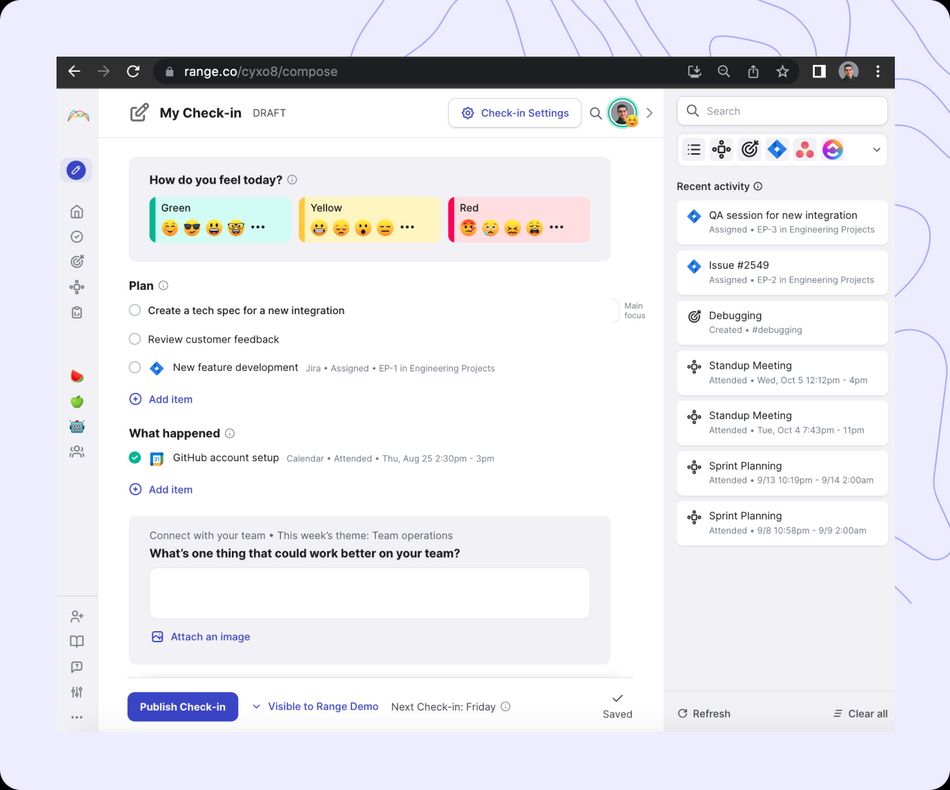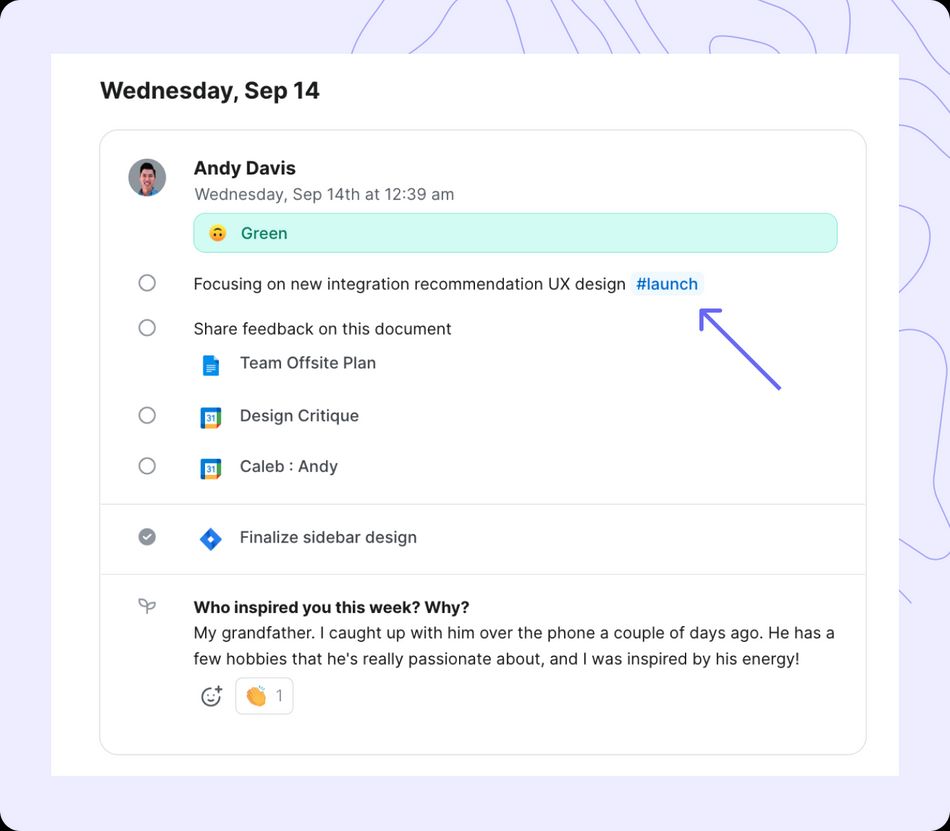Range is an asynchronous communication platform that teams use to promote engagement and work together more effectively.
Check-ins are the primary tool teams use to communicate in Range. At their core, Check-ins are asynchronously-shared status updates that show what individuals and teams are focusing on, what they need, and how they’re feeling.
How teams use Check-ins
Let’s start with a few examples of the most typical use cases for Check-ins:
- Running asynchronous engineering standups
- Communicating regular progress on daily and project-based work
- Removing simple status updates from team meetings (to reduce time spent in meetings)
- Sharing daily and weekly progress reports (as a more engaging alternative to email)
- Running standups in Slack
Even amongst the more common use cases, how a team chooses to use Check-ins has a great deal to do with a few factors that are unique to them, such as:
- Team size and function (e.g., engineering, sales, product)
- Team distribution (single or similar time zones vs. many or disparate time zones)
- Existing cadences and workflows
- Communication preferences
As you explore your Range workspace and settings, you’ll notice that there are some default settings already set up for you. For example, you’ll get reminders at 9:00 AM to publish Check-ins, and at 1:00 PM everyone will receive a summary of all the Check-ins shared by their teammates that day.
While our own team uses Check-ins daily, you might find that checking in on Monday, Wednesday, and Friday suits your routine. Pro tip: You can fully customize your team’s Check-ins schedule any time.
Why teams use Check-ins
Check-ins for ICs
For individual contributors on your team, knowing who’s working on what, recognizing opportunities to unblock others, and staying connected to teammates can be a real challenge. And this can often be true for teams regardless of whether they’re co-located or distributed.
Check-ins keep everyone aware of and engaged with what’s happening. The increased visibility into colleagues' specific tasks makes it easier to be proactive in providing feedback, resolving issues, and sharing necessary context to keep work moving forward.
Check-ins for managers
For managers and leaders, it’s hard keeping up with what everyone is working on, especially when your team is distributed. Trying to keep up often looks a lot like more 1:1s, more meetings, more emails, and more messages. This places increased demands on your time, and introduces further distractions for you and your team, ultimately getting in the way of actual work.
Check-ins make it easier for you to get an accurate pulse on what everyone on your team has prioritized in a given day or week, and it removes the need to ask for regular status updates.

Beyond progress and performance, Check-ins also provide managers and their teams with a snapshot of their team's overall wellbeing. Indicating your mood with a color and adding a bit of context with an emoji might seem simple and small, but it immediately shows you who might need extra support, when something might be affecting the majority of your team, and when it might be time to celebrate recent wins or schedule some fun.
How Check-ins work
What goes into a Check-in
There are four components that make up a Check-in: How do you feel today?, Plan, What happened, and Connect with your team.
- How do you feel today? — Take a moment to reflect on how you’re showing up on a given day using green, yellow, or red and add an emoji to contextualize your mood. For example, if you were up late the night before, you might check-in as 🟡 😴. Learn more.
- Plan — What do you plan to do today? What are you working on next? Here, we recommend sharing your top priorities, tasks, projects, and calendar events.
- What happened — What did you get done yesterday? What progress have you made recently? This is where you should attach work items directly through integrations or Range Sync (our Chrome Extension).
- Connect with your team — This section comes in two parts. First, you and your team will be asked a team-building question. On Mondays, you’ll be asked about your weekend. For the rest of the week, there will then be a theme, such as communication styles, superpowers, or celebrating success.
Supplemental Check-in features
Once you get in the habit of sharing Check-ins, writing them will become second nature. Even better, everyone will know what’s happening. As you do get more comfortable planning and communicating out your work each day, there are a few supplemental features that can bring even great value to your Check-ins.
- Flags — Flags allow you to raise items to your team’s attention. Check-in items with a flag attached will stand out among the rest. You can request feedback, ask for help, share milestones, and give gratitude.

- Tags — Using #tags helps you to categorize the work you include in Check-ins. You can categorize by goals (if you’re using Range’s Goals feature), project, type of work, or any category that is useful to you and your team.

- Main focus — If there’s a particular item that you’ve prioritized above all others on a given day, you can call it out by including it at the top of the ‘Plan’ or ‘What happened’ sections. You’ll notice these items will appear in bold when you publish your Check-in.

- Prompts — Check-in prompts are designed to help get you thinking about your work and what you need from your team. You might see a question asking if anything has blocked your progress or another prompting an update on a goal you’re contributing to.
Tips and best practices for Check-ins
Done right, Check-ins can set you up for success, making your team more effective, more productive, and better connected to one another.
Here are few tips to help you make the most of Check-ins:
- Write for your audience — Your teammates probably don’t have the same level of knowledge about your day-to-day work as you do, so it’s important to share a Check-in that gives the right context. Ask yourself: (1) What does my team know about my work? (2) Does my plan show how I’ll be moving projects forward? (3) Does it provide context on the stage of work? (4) Does my Check-in include specific tasks and actions I plan to accomplish today, rather than just “working on X”?
- Remember to link integrations — Range integrates with 75+ workplace apps, including Slack, Microsoft Teams, Google Drive, Asana, GitHub, and Jira. That means that if you work on a doc, complete a task, or merge a PR, they'll automatically appear in your activity sidebar, so you can include them in your Check-in.
- Flag items for more visibility — You can flag items to make sure your team sees them. To add a flag, click on the flag icon at the bottom right of the editor and select an option from the list.
- Always answer the daily question — The daily team question can seem like one more thing you have to do, but trust us, it actually helps your team work better together. The team questions are designed to help your team get to know one another, so you can build up psychological safety — the top predictor of team success. We recommend trying to be as open and honest as you can. Your team is there to support you.
Getting started with Check-ins
Now that you have a better understanding of why we created Check-ins, how they work, and how they help, you’re ready to start applying what you’ve learned.
Write your Check-in for today